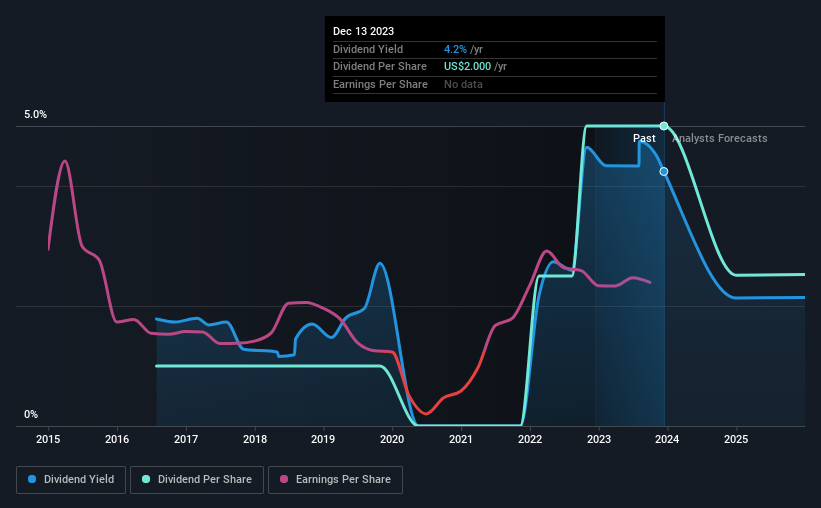- United States
- /
- Hospitality
- /
- NasdaqGS:RRR
Red Rock Resorts (NASDAQ:RRR) Is Due To Pay A Dividend Of $0.25

Red Rock Resorts, Inc. (NASDAQ:RRR) will pay a dividend of $0.25 on the 29th of December. The dividend yield will be 4.2% based on this payment which is still above the industry average.
Check out our latest analysis for Red Rock Resorts
Red Rock Resorts' Payment Has Solid Earnings Coverage
If the payments aren't sustainable, a high yield for a few years won't matter that much. Prior to this announcement, Red Rock Resorts' earnings easily covered the dividend, but free cash flows were negative. We think that cash flows should take priority over earnings, so this is definitely a worry for the dividend going forward.
Looking forward, earnings per share is forecast to fall by 32.3% over the next year. If the dividend continues along the path it has been on recently, we estimate the payout ratio could be 47%, which is comfortable for the company to continue in the future.

Red Rock Resorts' Dividend Has Lacked Consistency
Even in its relatively short history, the company has reduced the dividend at least once. If the company cuts once, it definitely isn't argument against the possibility of it cutting in the future. The annual payment during the last 7 years was $0.40 in 2016, and the most recent fiscal year payment was $2.00. This works out to be a compound annual growth rate (CAGR) of approximately 26% a year over that time. Despite the rapid growth in the dividend over the past number of years, we have seen the payments go down the past as well, so that makes us cautious.
Red Rock Resorts Could Grow Its Dividend
With a relatively unstable dividend, it's even more important to see if earnings per share is growing. We are encouraged to see that Red Rock Resorts has grown earnings per share at 7.1% per year over the past five years. With a decent amount of growth and a low payout ratio, we think this bodes well for Red Rock Resorts' prospects of growing its dividend payments in the future.
Our Thoughts On Red Rock Resorts' Dividend
Overall, it's nice to see a consistent dividend payment, but we think that longer term, the current level of payment might be unsustainable. While the low payout ratio is a redeeming feature, this is offset by the minimal cash to cover the payments. We don't think Red Rock Resorts is a great stock to add to your portfolio if income is your focus.
Companies possessing a stable dividend policy will likely enjoy greater investor interest than those suffering from a more inconsistent approach. Still, investors need to consider a host of other factors, apart from dividend payments, when analysing a company. To that end, Red Rock Resorts has 2 warning signs (and 1 which doesn't sit too well with us) we think you should know about. Is Red Rock Resorts not quite the opportunity you were looking for? Why not check out our selection of top dividend stocks.
New: AI Stock Screener & Alerts
Our new AI Stock Screener scans the market every day to uncover opportunities.
• Dividend Powerhouses (3%+ Yield)
• Undervalued Small Caps with Insider Buying
• High growth Tech and AI Companies
Or build your own from over 50 metrics.
Have feedback on this article? Concerned about the content? Get in touch with us directly. Alternatively, email editorial-team (at) simplywallst.com.
This article by Simply Wall St is general in nature. We provide commentary based on historical data and analyst forecasts only using an unbiased methodology and our articles are not intended to be financial advice. It does not constitute a recommendation to buy or sell any stock, and does not take account of your objectives, or your financial situation. We aim to bring you long-term focused analysis driven by fundamental data. Note that our analysis may not factor in the latest price-sensitive company announcements or qualitative material. Simply Wall St has no position in any stocks mentioned.
About NasdaqGS:RRR
Red Rock Resorts
Through its interest in Station Casinos LLC, develops and manages casino and entertainment properties in the United States.
Very undervalued second-rate dividend payer.
Similar Companies
Market Insights
Community Narratives



